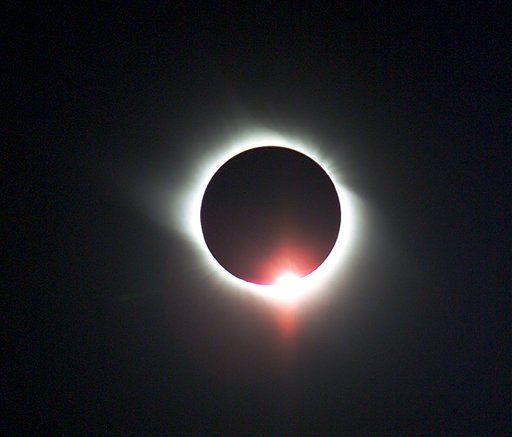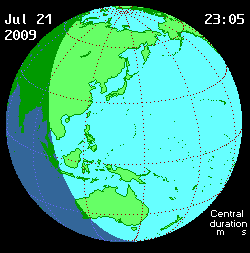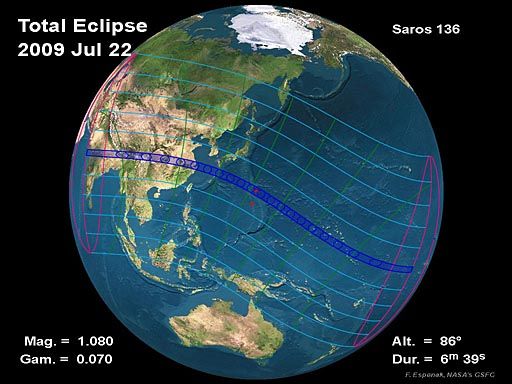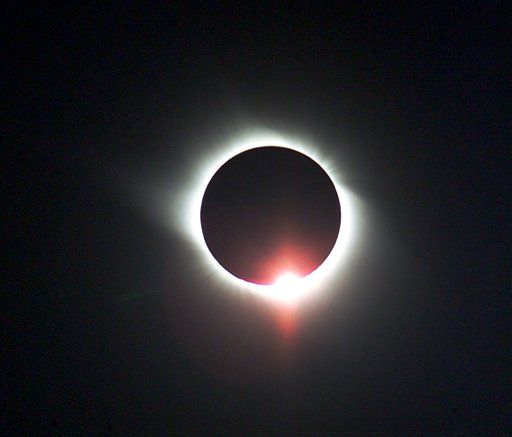
The solar eclipse tomorrow, (Wednesday July 22, 2009) is a total eclipse of the Sun. It will be the longest total solar eclipse of the 21st century, lasting at most 6 minutes, 39 seconds. The eclipse is part of saros series 136, like the record setting Solar eclipse of July 11, 1991. The next event from this series will be on August 2, 2027. The exceptional duration is a result of the moon being near perigee, with the apparent diameter of the moon 8% larger than the sun (magnitude 1.080.) No idea what that means but it sounds cool doesn’t it?

This is the second in the series of three eclipses in a month, with the lunar eclipse on July 7 and a lunar eclipse on August 6. This solar eclipse is the longest total solar eclipse that will occur in the twenty-first century, and will not be surpassed in duration until June 13, 2132. Lasting for up to 6 minutes and 39 seconds, with the maximum eclipse occurring in the ocean about 100 km south of the Bonin Islands, southeast of Japan. The uninhabited North Iwo Jima island is the closest landmass with the maximum time, while the closest inhabited point is Akusekijima, where the eclipse lasts 6 minutes and 26 seconds.
Wednesday’s eclipse will first be sighted at dawn in India’s Gulf of Khambhat, just north of Mumbai, before being seen in a broad swath moving north and east to Nepal, Myanmar, Bangladesh, Bhutan and China. The eclipse will reach its peak in India at about 6:20 a.m. local time (8:50 p.m. ET) lasting 6 minutes and 39 seconds at its maximum point.
If you just want to sit back and enjoy the view, you can see a live video stream of the eclipse from several locations in the world. The LIVE! UNIVERSE webcast will display a live webcast from Japan. The University of North Dakota has sent an expedition which will broadcast a live webcast from China; You can follow the live stream here. Grupo Saros will also have a live webcast from China, and on Ustream.TV you can follow the eclipse from Guwahati. Finally, for some more info on this eclipse, check out the amazingly resourceful Eclipse Chasers, the Exploratorium, and the Wikipedia page for the solar eclipse of July 22nd. 9And if all else fails there’s always NASA!)

Didjya Know?
A solar eclipse occurs when the moon comes between the sun and the Earth. Coincidentally the moon has essentially the same apparent diameter as the sun (it’s much smaller but also much closer), so when the moon and sun are lined up perfectly, the moon covers the sun, leaving only the corona (the glowing part of the solar atmosphere) visible.
Unfortunately, most people are lucky if they can see one total eclipse in a lifetime. Total eclipses are visible along only a narrow band of the Earth’s surface (and usually much of that’s the ocean), and they typically happen only about once a year. Upcoming eclipses will be visible from land in these locations:
* July 22, 2009, China, India
* July 11, 2010, southern Chile and Argentina
* November 13, 2012, northern tip of Australia
* November 3, 2013, central Africa
* March 20, 2015, scattered Arctic islands
* March 9, 2016, Sumatra, Borneo
* August 21, 2017, United States mainland
* July 2, 2019, southern Chile and Argentina
P.S. A word of caution: Cast away eclipse superstitions, but view safely!

